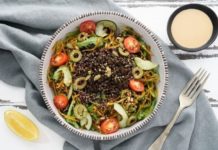
It’s no secret losing weight in a healthy way takes time: Experts agree it’s safe to shed 1–2 pounds per week. However, if the scale just won’t budge, don’t be discouraged — there are strategies you can use to overcome a weight-loss plateau.
“Listening to your body, challenging yourself with exercise, sleeping well, and managing your stress with enjoyable activities will all help you push forward in your weight-loss efforts,” says Melissa Mitri, RD.
Here, 10 simple ways you can reboot your weight-loss efforts if you’re not seeing results:
1
START A FOOD DIARY
Research shows logging what you eat and drink helps you lose weight and takes less than 15 minutes out of your day. “Tracking your intake using an app such as MyFitnessPal will provide you with valuable information on exactly what you’re consuming, and often it’s not what we thought,” says Mitri. Sipping sugary smoothies and soda or mindlessly snacking throughout the day can make losing weight that much harder, but when you keep an accurate food journal, you can set daily goals to better fuel your weight-loss success.
2
MAKE SURE YOU’RE NOT OVER-RESTRICTING
If you feel tired or moody and have trouble controlling your cravings, your body might be trying to tell you it needs more nutrition — and it could start fighting your weight-loss efforts. “If you’re following a diet that is below your calorie needs and eating too little, your body’s natural defenses kick in and it holds onto every ounce of food you take in,” says Mitri. As a result, your metabolism slows and this can set you up for a negative cycle of yo-yo dieting and regaining weight. “On average, you don’t want to go over a calorie deficit of 500 calories per day for healthy weight loss, but check with a registered dietitian to determine your calorie needs based on factors like your weight, activity level and any health issues,” says Mitri.
3
STAY HYDRATED
Drinking can help you avoid mistaking thirst for hunger so you feel a little less deprived when you’re consuming fewer calories than usual, says Keith Ayoob, RD. However, when you log what you’re drinking, you can begin to see just how much of an impact liquid calories in juice, soda and alcohol can have on your weight-loss efforts. To drink more water without getting sick of plain-old H20, stock up on zero-calorie flavored seltzers and try new recipes for infused water with fresh fruit, herbs and spices like ginger, he suggests. Slimmed-down cocktails and mocktails can make for a refreshing treat without a calorie bomb of added sugars and syrups.
4
GIVE YOUR BREAKFAST A PROTEIN BOOST
When you’re trying to lose weight, a common tactic is to skip breakfast or cut yours down to a single bagel, muffin, piece of toast or a bowl of cereal. The problem with this is you’re missing protein, a key macronutrient research shows can help keep you full longer, reducing hunger and the chances you’ll end up overeating at lunch or going overboard on snacks throughout the day, says Lauren Harris-Pincus, RD, author of the “Protein-Packed Breakfast Club.” A better weight-loss strategy is to aim for at least 20 grams of protein at breakfast with eggs, cottage cheese, Greek yogurt, smoked salmon or protein powder mixed into your cereal, oatmeal or smoothie.
5
BEWARE OF HEALTH HALOS
Just because a food is good for you doesn’t mean you can ignore healthy portion sizes: “I find many people place health halos around certain foods and forget that calories matter,” says Harris-Pincus. Case in point: “One tablespoon of oil (any kind) contains about 120 calories. If you’ve ever dipped bread into olive oil in a restaurant, it soaks up like a sponge. You could easily consume several hundred calories before the appetizers arrive.” Harris-Pincus often sees clients overeat popular healthy foods like avocados (there’s more than 300 calories in one fruit) and hummus (there are 80 calories in just 2 tablespoons, though most of us eat more than that in one sitting). Instead, portion out your food, no matter how healthy it is, with measuring spoons and cups so you start to recognize correct portions more easily.
6
FILL UP ON NON-STARCHY VEGGIES
On the other hand, there are some foods you can typically load up on like non-starchy vegetables like salad greens, peppers, cucumbers, mushrooms, broccoli and cauliflower, says Harris-Pincus. They’re low-cal and rich in vitamins, minerals and fiber, which help fill you up when you’re trying to lose weight. “It’s really tough to overeat veggies — just be mindful of the amount of oil or dressing you use to flavor them,” says Harris-Pincus.
7
UNPLUG YOUR MEALS
Throughout your weight-loss journey, it’s important to remember eating isn’t just ‘fueling up’— it’s something to be enjoyed fully in the moment. “Don’t eat in front of your TV, computer or while browsing your phone,” says Mitri. “Instead, sit at a table and enjoy your meal without interruptions whenever possible.” Mindful eating — focusing on and savoring each bite — helps prevent overeating; research in the American Journal of Clinical Nutrition shows you eat more when you’re multitasking and less when you pay attention to your meals. “Eating undistracted will allow you to be more in tune with your body to know when you’re starting to get full,” says Mitri.
8
TAKE ME TIME
There’s a big connection between stress and weight gain.“When you’re under chronic stress, the hormone cortisol can soar, increasing your cravings for unhealthy fare like high-sugar processed foods in an effort to temporarily relieve your stress and give you energy,” says Mitri. Over time, this can lead to weight gain and high inflammation. As difficult as it can be, try to cut yourself some slack and reduce your stress whenever you can. “Take frequent, short walk breaks throughout the day, call a friend, take a yoga class or have a cup of tea and journal,” suggests Mitri. “Giving yourself opportunities to decompress can have a big impact on your daily stress levels and recharge your energy.”
9
ADD A BRISK WALK TO YOUR ROUTINE
While it’s true abs are made in the kitchen, making time for exercise — and burning more calories than you consume — can help tip the scales in your favor. One of the easiest ways to do this is to schedule a fast-paced, 30–45-minute walk into your daily routine, says Morgan Rees, an LA-based ACE-certified personal trainer, fitness nutrition specialist and health coach. Whether you walk in the morning, on your lunch break or after dinner, the weight-loss benefits of walking are multifaceted. Walking can help you improve mood levels, connect with friends, get extra steps with your dog and take a much-needed breather from your busy life instead of turning to food for stress relief.
10
SHARPEN YOUR SLEEP ROUTINE
If you’re not getting enough shut-eye (Read: at least seven hours of uninterrupted sleep each night), it’s going to be even more difficult to lose weight. “The quality of your sleep affects your metabolism and levels of your hunger hormones,” says Mitri. That means when you’re sleep-deprived, you tend to feel hungrier and eat more compared to when you’re well-rested. The key to a healthy sleep routine is to schedule it in like any other priority: “Aim to keep your sleep patterns as consistent as possible, ideally going to sleep and waking up around the same time every day,” advises Mitri. Swap scrolling through your newsfeed or binge-watching a TV show for a relaxing bedtime routine, like a warm bath, gentle yoga or reading a book, she suggests.
Unlock an experience that’s like having a dietitian, trainer and coach — right at your fingertips. Go Premium for expert guidance and exclusive tools that will help you reach your personal health goals.
Originally published August 2019, updated with additional reporting


















